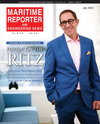
Page 53: of Maritime Reporter Magazine (July 2019)
Cruise Vessel Design & Outfit
Read this page in Pdf, Flash or Html5 edition of July 2019 Maritime Reporter Magazine
T
TRADE SHOW NORSHIPPING 2019 was for a 14,000 TEU container ship. closely behind, there was a palpable by arti? cial intelligence and underlying data infrastructure”, Kongsberg Vessel
Each vessel design was modi? ed from a tension from maritime stakeholders at- algorithms. Insight is a combination of hardware baseline concept that could run on HFO tending the Nor-Shipping conference To support the growing amount of data and software to conduct a broad range of to alternate designs which would accept when debating the best ways to achieve being sent from ship-board sensors to data analytics related to fuel consump- hydrogen fuel cells and liquid biofuels. these targets. The prevailing frustration shore-side servers for analysis, INMAR- tion, engine state and load, and generator
Tikka described these top level designs stemmed from uncertainly in how these SAT announced plans to partner with state. Looking out over the conference as “aspirational realistic designs”. “They upcoming IMO regulations would be ap- Airbus Defense and Space to launch a hall, one was able to grab a brief glim- are aspirational in the sense that they are plied and changed over time. series of new satellites in the coming mer of the future state of ocean going for the future, but they are realistic in the years. According to INMARSAT’s press vessels. Over time, vessels will be more sense that they were developed using the announcement, this additional invest- automated and produce fewer emissions. same principles that you would develop ment was made to support an expansion Decision making including route plan-S MHIP ANAGEMENT any basic design”. In additional to operational changes, of the Fleet Express product which is a ning and ship maintenance will occur
Other conversations during the Nor- and alternate fuel systems, there were a combination of the legacy Fleet Broad- seamless between the few individuals
Shipping conference focused on the im- plethora of companies at Nor-Shipping band L-band service and the newer high onboard a vessels and a support team mediate concerns related to IMO’s 2020 offering products designed to optimize speed Global Xpress Ka-band service. ashore. Wizened sailors, ? eet manag- regulations on SOx emissions. A brief ship management and produce fuel sav- Representing a source of this expand- ers, and business-minded investors will interview with Peter Strandberg, CEO, ing from interconnected marine systems ed maritime system data, Kongsberg be joined by techies, programmers, and
Yara Marine Technologies, illuminated and advanced analytics. More speci? cal- maritime held a press announcement data analytics professional to propel the some of the bene? ts and challenges re- ly, several companies claimed that opti- to unveil the Kongsberg Vessel Insight maritime industry into the next century. lated to maritime gas scrubbers mized decision making could be made system. Described as a “vessel-to-cloud
When asked about the balance between reducing local SOx emissions and the additional fuel used to power the scrub- bers, Strandberg offered the follow- ing, “you will consume a little bit more fuel because of the energy [required to power the scrubber], but to cooperate with HFO then the scrubber is the best alternative… Either you can re? ne it twice [at the re? nery] and have double
CO2 [emission] or you can put [HFO] directly on the vessel and burn it there.
If you have the HFO and scrubber you will reduce your particle emission up to 80 percent”.
Further discussions with Strandberg revealed a public debate on the ef? - cacy of closed loop versus open loop gas scrubbers. SOx scrubbers pass ex- haust gas from marine engines through a “scrubbing cloud” of water droplets which capture emission particles from the exhaust gas. In the open loop con? g- uration, the water used in the scrubbing process is discharged overboard while in the closed loop con? guration water is re- circulated and treated with either caustic soda or Magnesium Oxide. Referring to a recent ban by Singapore on open loop scrubber, Mr. Strandberg stated “We, the scrubber suppliers, have to do a better job to inform the public and the govern-
OneSea: ment about the scienti? c facts”. He went
The general location of the on to reference past and on-going work with DNV-GL to assess the environmen-
Jaakonmeri test area for tal impact of open, closed, and hybrid autonomous maritime gas scrubbers.
vessel technology.
With 2020 IMO regulations taking ef-
Photo: One Sea fect at the beginning of next year and 2030 and 2050 GHG targets following www.marinelink.com 53
MR #7 (50-57).indd 53 7/3/2019 9:29:58 AM

 52
52

 54
54
